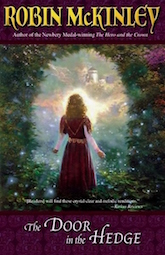The Door in the Hedge is a collection of four longish short stories, all reimaginations of fairytales, and first published in 1981. I must have first read it not long after that. Way back then, not many people were retelling fairytales, and the only other such book I’d come across was Angela Carter’s The Bloody Chamber. The Door in the Hedge isn’t that at all, and it’s interesting to think why not. They’re both unquestionably feminist reimaginations of the same kinds of European stories. But Carter was dragging her fairytales kicking and screaming and thrusting them bloody before us, while McKinley wants them still to be fairytales. Just… fairytales where the princesses have agency, where they are active and do things rather than having things done to them, but where they can still, after all, live happily ever after.
What McKinley has always been brilliant at is the kind of close up detail that make the lands of “once upon a time” feel solid. She’s not writing in real Medieval Europe or Hollywood Medieval Europe (as neatly parodied in Diana Wynne Jones’s Fantasyland); she’s writing out on the borders of Faerie, where there are tiny blue flowers and long gold ribbons and red cloaks that grow heavy when you pour drugged wine into them and where kings and queens retire into the mountains. Everything is very clean and nice and well organized and beautiful, except the evil things, which are ugly and will be properly defeated and put back in the box at the end of the story. In this universe goodness and nobility are real, and kings just naturally possess them. The stories are charming rather than dark. But isn’t that charm part of what we always liked about fairytales? These are like children’s stories, except that the people are real, and actions have consequences.
This isn’t “Seasons of Glass and Iron” or Grimm for that matter—these stories keep well away from the horror that lurks in fairytales. There’s a place where the traditional fairytale meets horror head on, and McKinley knows about that and went there in Deerskin. But Deerskin was ten years later, she wasn’t there yet, and neither were the rest of us.
It’s hard to remember, but when McKinley wrote these stories, princesses were not everywhere. It was before the Disney explosion, before little girls were deluged with pink sparkly princess tat. And McKinley was one of the first people to write empowered princesses. In one of these stories the princess saves the prince, and when I first read it in the early Eighties that was startling. We’ve come a long way since then, on a lot of fronts. That makes The Door in the Hedge seem a lot tamer. But part of the reason we have come a long way is because of books like this, because writers like McKinley brought us forward one step at a time, not always head-on into the unsettling but slowly, easing us along with charm and agency and little domestic details.
 I picked this book up again now because it was available as an e-book at a low low price that, as has become my recent habit, made me buy a copy of a book already on my shelves, so that I can reread it wherever I am. You need to have one for a while before you realise an e-reader is a re-reader’s best friend. Everything is with you all the time; if something reminds you of a book, the book is immediately to hand.
I picked this book up again now because it was available as an e-book at a low low price that, as has become my recent habit, made me buy a copy of a book already on my shelves, so that I can reread it wherever I am. You need to have one for a while before you realise an e-reader is a re-reader’s best friend. Everything is with you all the time; if something reminds you of a book, the book is immediately to hand.
The Door in the Hedge is a book from early in McKinley’s career, and not her best work. I had forgotten quite how princessy it is. All the same, reading it now, I found myself being charmed by it all over again.
Jo Walton is a science fiction and fantasy writer. She’s published a collection of Tor.com pieces, three poetry collections and thirteen novels, including the Hugo and Nebula winning Among Others. Her most recent book is Thessaly. She reads a lot, and blogs about it here irregularly. She comes from Wales but lives in Montreal where the food and books are more varied.











Well away from horror? The people of the Last Kingdom live in constant fear for their children, in terror of waking one morning to an empty bed or an empty crib strewn with fairy flowers. The nameless princess of The Princess and the Frog lives in fear in her own home now dominated by a wicked sorcerer. The sad little princess in the Hunting of the Hind nearly loses the one person who really loves her. And of course the Twelve Dancing Princesses are doomed to watch helplessly as they are used in a plot to take over their kingdom.
All that seems quietly horrific to me.
Oops double post.
Good article. And I know this isn’t about the book but I so totally agree with you about the ereader being a rereaders best friend. I’ve done the same thing, found a book I read years ago very very cheap and decide to try it again. Or sometimes it’s a book I read that everyone says I should have really liked and didn’t and its free so I’ll give it second chance. I was always the person who had at least two books on me at all times (didn’t want to finish and be caught without), so to walk around with hundreds of books just waiting for me to open is wonderful. And Dickens and Shakespeare you can find for free!!!
Yes, Ebooks are wonderful. I always take mine with me when I’m going to the doctor or anywhere else I might have to wait a while. The problem is there’s a limit to how many books you can have downloaded and ready to read at a time.
Um, the limit on an old one is 1000, and after 4 years I had filled my old one up and bought a new one where the limit seems to be about 5000. That is indeed “a” limit, but it’s not much of one!
I just opened The Door in the Hedge and read the first story. I enjoyed it. It was a relaxing story; I could feel my blood pressure drop as I read it. Not that it didn’t have tension. Worrying about losing a child is certainly tense. But it felt like everything would be all right by the end of the story, throughout. So I felt peaceful while reading it.
I’ve started the second story but it feels a little more tense to me. I still think everything will work out but I sense a confrontation coming and that raises the tension for me.
I look forward to reading the rest of that story and the others in the book. But I think I’ll save them for when I feel the need to be calmed by a story rather than exhilarated.
@5, As near as I can tell the number of books you can have in the cloud is unlimited the problem is unless you’re in a WiFi hotspot you can’t download them to read. At least with my old Nook. I’m still learning about my new Nook. I’ve got a few hundred books on the old one and that impressed the girl at the troubleshooter counter.
PrincessRoxana — so download everything right now while you have wifi, hey? Then they are on your device forever. I don’t know about the Nook, but with the Kindle, once they’re downloaded, they’re still there always unless you tell it to remove them from the device. I have literally never used mine any other way — nothing is “in the cloud”, I buy the book, or I download it from Gutenberg, and then I put it on and there is is, always, whenever I want it. I connect to wifi for 30 seconds at a time to download stuff and then turn it off again. When I got the new one, it took me a few hours to download the 1000 books I already had and resort them into their collections. But anything I’ve bought since March 2014 when I bought it, I have right there, whether there’s wifi or not. I bought the thing for travel in the first place. It’s the infinite “library in your pocket” nature of the thing that makes it great. Just download them. There is no downside.
On my reader there is a limit: if you have too many files it takes forever to start because listing all the files is very slow and you can’t do anything until the list of all files has loaded. I can’t use the whole available memory for books because it becomes unusable long before it is full.
@@@@@ birgit, Me too. Is yours a Nook?
It’s TrekStor.